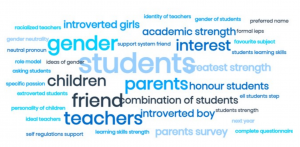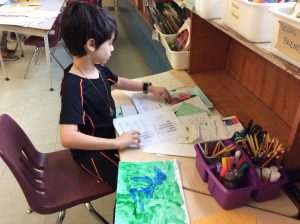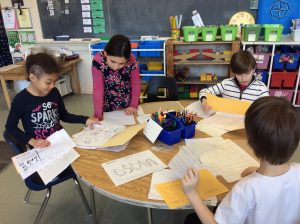November is interview time. Interviews are an important connection with the home to communicate progress in learning. After the last 2 years of disrupted school, it is also going to be a very important connection to speak about student’s social and emotional well being.
Over time, every teacher develops their own approach to completing so many important phone calls/interviews in one evening and morning according to their professional judgement. I have seen a variety of different interview styles all be successful. Some teachers prefer to run student led conferences where students present their own work and discuss their goals for the school year while teachers facilitate the conversation. Other teachers prefer to directly discuss the students’ strengths and weaknesses directly with parents or guardians.
For me, my approach is to write down notes on every child before the interview night and discuss them with parents or guardians. I do this because during my very first interview night, many years ago, I didn’t write any notes before hand. I was confident that I knew my students and could talk about them forever! What I didn’t factor in was what would happen to my brain after 3 hours straight of talking about a variety of students. During my very last interview, I hesitated to describe a positive trait about a very vulnerable student that I taught. I was so very disappointed in myself as I knew a thousand wonderful things about this student, but my brain was fatigued. Ever since that moment, I always prepare notes. I also have found that it provides a good record of what was discussed.
My notes that I prepare answers 4 basic questions and leaves 1 area for questions that come up during the interview:
One Positive aspect about the child and/or their progress this year
I always start with a positive aspect about the child. It often sets the interview on the right note and tells the family that I really care and know their child. I will try to share something about their academic progress and something about their positive role in the classroom and/or school. For example, “We are so happy to have Ishmeet in our class this year. She is such a positive and outgoing member of our class and really works hard to make sure her classmates are included in all classroom activities. When we were working on our Science experiments last week, she saw that one student was left out and she went over and invited them into her group. It really helped the other student to be successful because they felt included. Ishmeet has also had a great start to the year in reading. She actively participates in our small group conversations, and she passionately talks about her book that she has self-selected. She can read new words and use strategies to figure out their meaning. Continue to encourage her to read at home.”
One area of growth
I try to focus this part of the conversation about one academic area that the child is working on improving. For this part of the conversation, I always have examples of the student’s work and an example of work that would be assessed at an A level. I find having samples for parents makes it much more easy for them to identify and see why I have evaluated their child’s classroom work at a given level. For example, “One area that Aria is working on improving this year is writing. As you can see from her most recent writing assignment, Aria does a great job organizing her ideas and writing her thoughts in paragraphs. To improve her mark in writing, Aria needs to add more complexity to her sentences and add more vivid vocabulary to her assignments as you can see in this A level sample here.”
What I am doing to support their child
During this part of the interview, I reiterate my commitment to their child’s learning this year. I clearly outline specifically my plan for supporting their child’s progress. For example, “I have noticed that Harini is having a difficult time understanding the Mathematical concepts of money. During our math periods this week, I have been meeting with Harini and 3 other students in a small group every day to help support her understanding of money. Next week, we will be having an assignment that uses the knowledge about money that we have been practicing. I will follow up with you before that assignment if I feel that Harini needs more time and practice to develop her skills in this area.”
The Home-School Connection
Finally, I thank the parent or guardian for meeting/talking with me today and highlight how important the connection between home and school is. It is often at this point in the interview that many caregivers ask for guidance on how to support the child’s learning at home. When you are asked this question it is important to keep in mind that not all parents have access to the same resources, time or supports in their home or community. Just like my students, I want to set parents up for success and I need to be flexible and responsive in my answer. For example, in my new role supporting English language learners, many families asked how they could support their child in reading when they didn’t speak English themselves. I responded by encouraging them to discuss what their child is reading in their first language and modeled what that conversation might sound like. With another family that I worked with in my previous role who wanted to understand how to support their child, I provided a resource that gave step by step instructions on how to develop reading skills and we met and role-played how that might look in their home. Ultimately, I highlight with the parent the many ways they already help their child be successful at school such as sharing their own life experiences and involving the child in family activities. An example of this unconventional way that a father supported his daughter’s learning was when she clearly made a connection between the text she was reading and her father’s experiences driven into child labour that he had shared with her. It is important as teachers, that we recognize the many ways parents, guardians and families support our students every day.
Do you have any questions?
I usually end with an opportunity for parents to ask questions. If the parent has a lot of questions, ask them to have a follow up meeting so that you are able to respect the time of all the parents who will be meeting with you tonight.
Final thoughts:
- It is okay to say that you are not sure about an answer and that you will follow up with the answer next week. I sometimes get asked about high school programs or opportunities for extra curriculars that I don’t know about. I write down the question and follow up with the parent the following week.
- Stop the interview immediately if you are feeling threatened. Do not take abuse or put yourself in a dangerous situation. Call the office immediately and stand outside your classroom until the situation is resolved.
- I always end the interview with a reminder to parents that they can call, email, or make an appointment to chat any day throughout the year. My door is always open!!
- Ultimately, the parent wants to know that you care about their child as much as they do. If you go in with a positive tone, most interviews will be successful no matter what approach works best for you.



